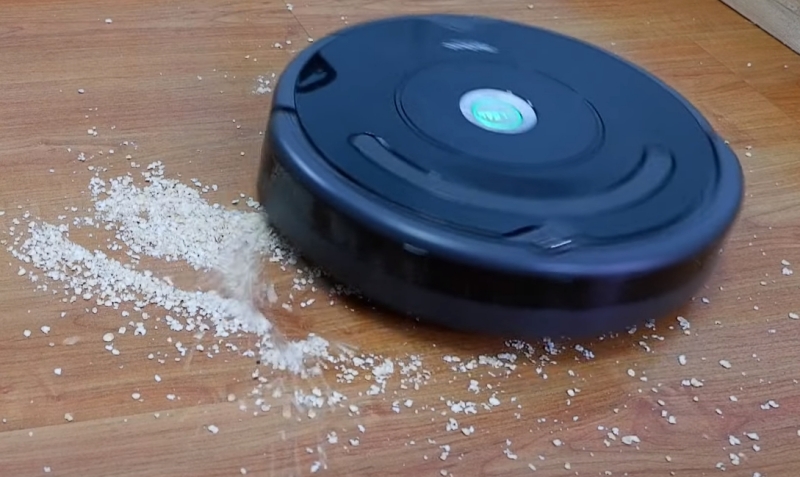In the comparison between Roomba 694 vs 960, I can confidently say that the Roomba 960 is the better. The Roomba 960 costs more than the Roomba 694, but it also offers more quality and features. The Roomba 694 is a lower-cost option that can still perform well and connect to WiFi.
The Roomba 960 has a better cleaning performance, especially on carpets and pet hair. It has also upgraded its navigation technology, using iAdapt 2.0 and vSLAM technology, which includes a camera and sensors to map and clean my home. Moreover, the Roomba 960 will automatically return to its dock to recharge and then continue cleaning where it leaves off.
The Roomba 694 can adapt to different floor types and avoid stairs, but it uses a random reactive navigation system to move around the house. However, it faces challenges in hair-tangling resistance. In short, the 694 model is a budget robot vacuum with good cleaning performance for daily cleaning.
Roomba 694 Vs 960: Comparison Chart




Roomba 694 Vs 960: Differences
Between Roomba 690 vs 694, the 960 model wins 4-0 against the 694 one. Both of them are good for daily home cleaning, but the Roomba 960 performs relatively better in all aspects.
Cleaning performance
Winner: Roomba 960
Suction
The suction of the Roomba 60 is a bit higher than that of the 694. As the suction variation between them is small, it is hard to spot the significant difference in cleaning tests. Besides, both Roomba models have one suction mode and do not feature the automated suction adjustment function like higher-tier Roomba models i7 or S9.
| Roomba 960 | Roomba 694 | |
|---|---|---|
| Airflow (cfm) | ~9.5 | ~7 |
Hard floors
Both the Roomba 690 and 960 perform decently on hard floors in terms of picking up small and light debris, such as cat litter and cereals. They can suck in such things in one pass. However, with heavier and fine debris like sand, they often leave the debris behind after a full pass owing to the low suction. So, they have to run extra passes to get the floor cleaned up completely.
Their fast and strongly spinning side brushes seem to do a relatively good job in edge cleaning as they help pull out the debris and dust for the bots to pick up easily. However, there is one problem: they scatter large mess of debris on hard floors noticeably, making the cleaning time longer.

Carpets
The Roomba 694 transition between bare floors to carpet is not really effective as it contact with the carpet’s edges and turns around. It seems that the 694 model thinks that the edge is a barrier or something and refuses to go on. Meanwhile, the Roomba 960 makes a nice transition between hard floor to carpet.
For pick-up efficiency on the carpet, the Roomba 960 does a better job in the tests. Its pickup efficiency is about 86% on medium-pile carpets and about 92% on low-pile carpets. The Roomba 694 performance is relatively lower but still better than many other bots in the same price range.
Both show decent cleaning on soft, high-pile, or fluffy carpets, thanks to their main dual brush rolls. However, I noticed that the Roomba 694 faces difficulty moving on such types of carpet as the carpet fibers tend to obstruct its bristle brush roll.
| Roomba 960 | Roomba 694 | |
|---|---|---|
| Medium carpet | ~ 88% | ~ 86% |
| Low carpet | ~ 92% | ~ 90% |
Hairs
Both can deal with pet hair and human hair very well. They can collect short and long strands of hair in one or two passes. However, the Roomba 960 is more excellent in hair-tangling resistance owing to the utilization of a rubber brush as a replacement for the bristle brush like on the 694 model.
With a 10-inch hair resistance test, the Roomba 960 can reduce up to 89% of hair caught on the roller. Meanwhile, that number of Roomba 694 falls to about 78%.

Design & Convenience
Winner: Roomba 960
Navigation & Mapping
The Roomba 694 model relies on random reactive navigation, which means they use sensors to detect bumps and dirt as they move around the house. For me, the Roomba 694 does a decent job in small rooms, where they can cover most of the floor area. But in larger spaces, they tend to miss many spots, especially under and around furniture, because of their random movement pattern.
On the other hand, the Roomba 960 upgrades its navigation capability with the vSLAM and updated iAdapt 2.0 navigation technology. The vSLAM technology, using the top-mounted camera, allows the Roomba 960 to map my house. It can recognize the furniture in the room and navigate in neat, straight rows. With the change to a straight navigation pattern, I found that the Roomba 960 provided better coverage even in small and large rooms.
Apart from such differences, both bots feature dirt sensors and cliff sensors. The dirt sensor helps detect the dirtier areas so they can clean such areas more thoroughly. The cliff sensors on the Roomba 960 and 694 work perfectly in preventing them from falling down stairs.

Obstacle avoidance
The Roomba 960 and 694 do not have an obstacle avoidance function like the advanced Roomba J7. They bump into furniture constantly and push the shoes and plastic cans I placed on the floor. They also run over and drag the charging cords, electric wires, or socks either. Thus, I have to pick up every item on the floor before the Roomba 960 or 694 start cleaning.
Yet, both of them are compatible with the Virtual Wall barrier for setting boundaries to prevent the bots from going into areas with many obstacles, like cords and wires. With the Roomba 960, this virtual wall is included in the box. However, in the case of the Roomba 694 package, you need to purchase the virtual wall separately.
Battery & Noise
| Roomba 960 | Roomba 694 | |
|---|---|---|
| Battery life (Max) | ~ 75 minutes | ~ 90 minutes |
| Charging time | ~ 2 hours | ~ 2 hours |
| Noise level | ~ 66-72 dB | ~ 65-71 dB |
The Roomba 960 has a shorter battery life than the Roomba 694, about 15 mins shorter, as you can see in the table above. However, the Roomba 960 has the smart charging and resume function, which I consider compensation for its shorter battery life. Particularly, the Roomba 960 automatically returns to its charging dock when the battery runs low and resumes cleaning where it left off once the battery is charged sufficiently.
Depending on the types of surfaces they are cleaning, the noise level of the Roomba 694 and 960 models can range from 65 to 71 dB. This noise can be annoying for some people who are sensitive, but I think it’s acceptable.
Control
Winner: Roomba 960
Physical control
The Roomba 960 still keeps three buttons: Dock, Power & Clean, and Spot functions like on the Roomba 690. Yet, the position of these buttons is modified. Instead of staying in the vertical line, they are repositioned horizontally with the Dock button on the left and the Spot button on the right of the Clean & Power button.
Using the Dock button, the bots will stop cleaning and return to their charging docks right away. The Spot button will control them to intensively clean the targeted region where you put them. The Clean& Power button lets you start, pause/resume, or stop the bots from cleaning.

App control
The Roomba 960 and 694 have wifi connectivity and can be controlled via the iRobot Home app and voice commands through Google Assistant or Amazon Alexa.
The app has basic features, including notifications of the bots’ status, the cleaning history, and the cleaning schedule. Both of them offer me 7 settings for scheduling the cleaning time in a week. I really like the scheduling feature and often use it to get the bots to clean my entire house when I leave home for work.
Neither the Roomba 960 nor the Roomba 694 can save maps for advanced cleaning properties. In fact, the Roomba 960 has vSLAM technology for home mapping, but it does not provide the map-saving feature in the app. However, the app of the 960 model provides the Clean Map report for easy checking of where the vacuum has been cleaned or missed.

Cleaning & Maintenance
Winner: Roomba 960
With rubber brush rolls, the tangled hair is on the Roomba 960 much easier to clean than on the 694 model with the traditional bristle brush. Besides, you need to check the side brush and castor wheels of these robot vacuums regularly to remove the stuck hair and dust so that they can offer the best performance.
The Roomba 960 also has a small upgrade in its filtration system with the utilization of a HEPA filter. The Roomba 694, on the other hand, uses the standard filter. The HEPA filter is particularly beneficial for pet owners as it is effective in capturing microdust and allergens. In addition, people with allergies or asthma prefer using vacuums with HEPA filters. However, the HEPA filter of the Roomba 960 is not washable, so you need to replace it after a period of 3 or 6 months.
Quick Rundown of iRobot Roomba 960
Quick Rundown of iRobot Roomba 694
- Design: Sleek, premium design complements your home decor; The Roomba 694 is a great way to begin cleaning your home smarter. Just schedule it to clean up daily dirt, dust, and debris with the iRobot Home app or your voice assistant. - for effortlessly clean floors
- Auto-Adjust Cleaning Head: Auto-Adjust Cleaning Head automatically adapts its height to effectively clean carpets and hard floors
- Adaptive Navigation: A full suite of advanced sensors allows Roomba to navigate under and around furniture, and along edges. Cliff Detect keeps it from falling downstairs
- Clean Floors Every Day: The Roomba 694 provides a system of cleaning features and smart sensors that allow the robot to adjust to your unique home and deliver a daily clean
- Automatically Recharges: The Robot Vacuum runs for up to 90 minutes before automatically docking and recharging
Product Videos
Related Articles to Roomba 960
- Roomba 960 Vs I4: Which Robot Vacuum Is Better?
- Roomba i3 vs 960: Which iRobot Roomba Is The Most Affordable Option?
Related Articles to Roomba 694
- Roomba 692 vs 694: 2 Of The Best iRobot’s Budget-friendly Robot Vacuums
- Roomba E6 Vs 694: Is There Any Upgrade In iRobot Entry-Level Robot Vacuums?
- Roomba 690 Vs 694: Compare Two Budget-Friendly Robot Vacs – Are They Different?
- Roomba 694 vs i1: Detailed Comparison – Are There Any Differences?
- Roomba 691 Vs 694: Are There Any Differences?
- Roomba 675 vs 694: Which Is The Best Option For Entry Level?
References:
- iRobot Roomba 960: https://www.irobot.com/en_US/roomba-vacuuming-robot-irobot-roomba-restored-960/R960R99.html
- iRobot Roomba 694: https://www.irobot.com/en_US/roomba-vacuuming-robot-vacuum-irobot-roomba-69-4020/R694020.html

Richard B. Schmidt is a prominent figure in the vacuum cleaner industry, boasting over 15 years of expertise. Armed with a Robotics Engineering degree from Northeastern University and a Master’s in Consumer Science from Harvard, his unique blend of technical knowledge and consumer insights positions him as a sought-after authority in vacuum cleaner evaluation. Richard’s career began at Dyson, where he contributed to the development of innovative vacuum models. Transitioning to advocacy and reviews, he co-founded the first Vacuum-focused blog in 2008, offering comprehensive analysis and user guides for various vacuum cleaners. In 2020, he founded RoboMop.net, providing ongoing insights through columns and buyer’s guides.
